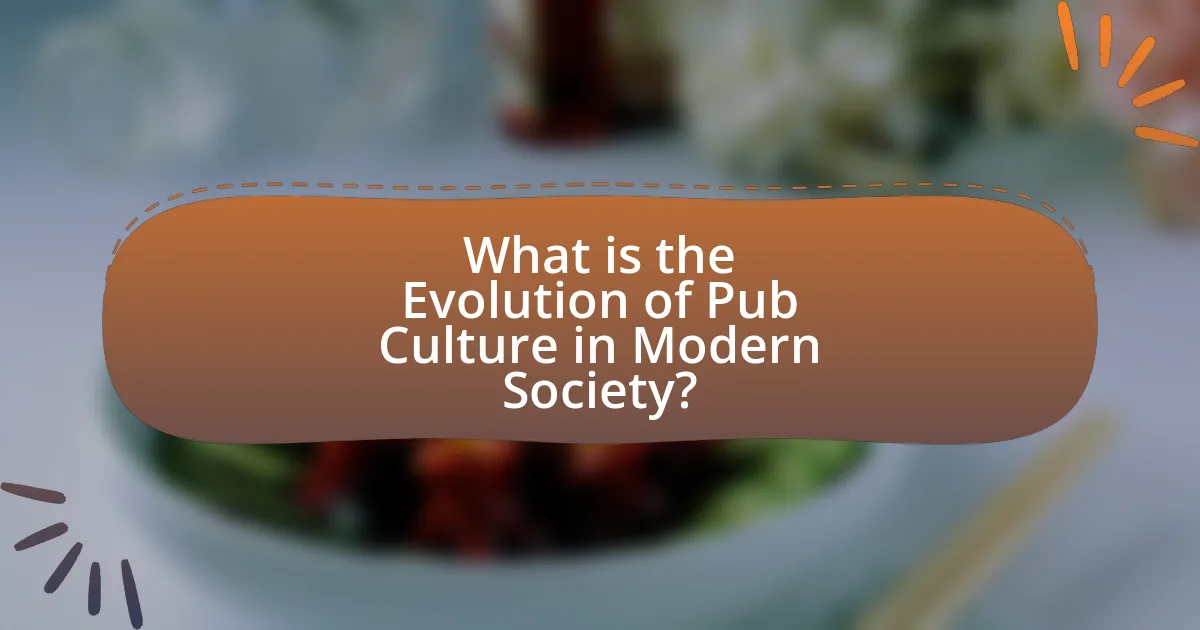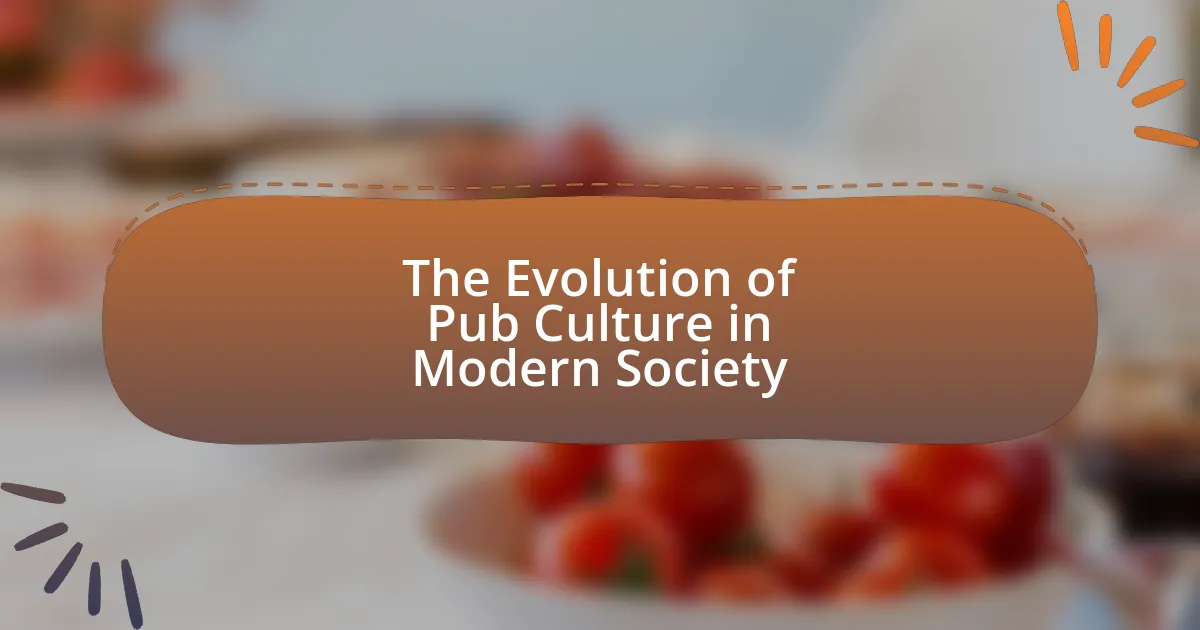The article examines the evolution of pub culture in modern society, highlighting significant changes in social interaction, drinking habits, and community engagement. It traces the historical role of pubs as social hubs and discusses the impact of technological advancements, the craft beer movement, and the COVID-19 pandemic on contemporary pub experiences. Additionally, the article explores how societal attitudes towards drinking have shifted, the economic contributions of pubs, and the challenges they face in adapting to changing consumer preferences and demographic trends. Key characteristics of modern pubs, including their role in fostering community and promoting responsible drinking, are also addressed.

What is the Evolution of Pub Culture in Modern Society?
The evolution of pub culture in modern society reflects significant changes in social interaction, drinking habits, and community engagement. Historically, pubs served as central social hubs where people gathered for conversation, entertainment, and community bonding. In recent decades, the rise of technology, such as social media and mobile communication, has transformed how individuals connect, leading to a decline in traditional pub attendance.
Moreover, the craft beer movement has revitalized interest in pubs, with many establishments focusing on unique, locally sourced beverages and creating inviting atmospheres that encourage socializing. According to a report by the British Beer and Pub Association, the number of craft breweries in the UK increased from 500 in 2010 to over 2,500 in 2020, indicating a shift towards diverse drinking experiences that attract a younger demographic.
Additionally, the COVID-19 pandemic has further influenced pub culture, prompting many establishments to adapt by offering outdoor seating, takeaway services, and virtual events, which have reshaped the traditional pub experience. This adaptability highlights the resilience of pub culture in modern society, as it continues to evolve in response to changing social dynamics and consumer preferences.
How has pub culture changed over the decades?
Pub culture has evolved significantly over the decades, transitioning from traditional social hubs to more diverse and specialized venues. In the mid-20th century, pubs primarily served as local gathering places for communities, emphasizing social interaction and local brews. By the 1980s and 1990s, the rise of chain pubs and themed establishments began to reshape the landscape, introducing a focus on food and entertainment alongside drinks.
In recent years, the emergence of craft breweries and a growing interest in artisanal beverages have further diversified pub offerings, catering to a more discerning clientele. According to a 2020 report by the British Beer and Pub Association, the number of craft breweries in the UK increased from around 500 in 2010 to over 2,500, reflecting a shift in consumer preferences towards unique and locally sourced products. Additionally, the impact of technology, such as online reservations and mobile ordering, has transformed the pub experience, making it more accessible and convenient for patrons.
What historical events influenced the transformation of pubs?
The transformation of pubs has been significantly influenced by several historical events, including the Industrial Revolution, the establishment of licensing laws, and the impact of World War II. The Industrial Revolution, which began in the late 18th century, led to urbanization and increased working-class populations, resulting in a demand for social spaces like pubs. The introduction of licensing laws in the 19th century regulated pub operations, shaping their role in society and promoting responsible drinking. Additionally, World War II brought about changes in social dynamics and the need for community gathering places, further evolving the pub’s function from mere drinking establishments to vital social hubs. These events collectively contributed to the modern identity of pubs as integral parts of community life.
How have societal attitudes towards drinking evolved?
Societal attitudes towards drinking have evolved from acceptance and normalization to increased scrutiny and health consciousness. Historically, alcohol consumption was widely accepted in social settings, with pubs serving as central community hubs. However, in recent decades, there has been a shift towards recognizing the health risks associated with excessive drinking, leading to campaigns promoting moderation and responsible drinking. For instance, the World Health Organization reported that harmful use of alcohol contributes to over 3 million deaths annually, prompting public health initiatives aimed at reducing consumption. This evolution reflects a growing awareness of the social and health implications of drinking, influencing policies and individual behaviors.
What role do pubs play in contemporary social life?
Pubs serve as vital social hubs in contemporary life, fostering community interaction and cultural exchange. They provide a space for individuals to gather, socialize, and build relationships, contributing to social cohesion. Research indicates that 70% of adults in the UK visit pubs regularly, highlighting their importance in social routines. Pubs also host events, such as trivia nights and live music, which enhance community engagement and provide entertainment. Furthermore, they often serve as informal venues for discussions and networking, reinforcing their role as essential components of modern social life.
How do pubs serve as community hubs today?
Pubs serve as community hubs today by providing a social space for local residents to gather, connect, and engage in communal activities. They often host events such as trivia nights, live music, and sports screenings, which foster a sense of belonging and community spirit. According to a 2021 report by the Campaign for Real Ale (CAMRA), 70% of pub-goers believe that their local pub plays a vital role in bringing people together and enhancing community cohesion. This demonstrates that pubs are not just places to drink but are integral to the social fabric of neighborhoods, facilitating interactions among diverse groups and supporting local culture.
What impact do pubs have on local economies?
Pubs significantly contribute to local economies by generating employment, stimulating local spending, and attracting tourism. They create jobs not only within the establishments themselves but also in related sectors such as food supply, entertainment, and transportation. For instance, a study by the British Beer and Pub Association found that the pub sector supports over 900,000 jobs in the UK alone. Additionally, pubs often serve as community hubs, encouraging local spending on food, drinks, and events, which in turn supports other local businesses. Furthermore, pubs can attract tourists, enhancing the local economy through increased visitor spending. According to a report from the Campaign for Real Ale, pubs contribute approximately £23 billion to the UK economy annually, highlighting their vital role in economic activity at the local level.
What are the key characteristics of modern pub culture?
Modern pub culture is characterized by a blend of social interaction, diverse beverage offerings, and a focus on community engagement. Social interaction is central, as pubs serve as communal spaces where people gather to socialize, watch sports, and participate in events like trivia nights. The beverage offerings have expanded beyond traditional ales to include craft beers, cocktails, and non-alcoholic options, catering to a wider audience. Community engagement is emphasized through local events, live music, and partnerships with local businesses, fostering a sense of belonging. These characteristics reflect the evolving role of pubs as not just places to drink, but as vital social hubs in contemporary society.
How do modern pubs differ from traditional establishments?
Modern pubs differ from traditional establishments primarily in their design, offerings, and social atmosphere. While traditional pubs often feature a rustic decor, wooden furnishings, and a focus on local ales, modern pubs tend to embrace contemporary aesthetics, incorporating sleek designs and varied seating arrangements. Additionally, modern pubs frequently offer a wider range of beverages, including craft cocktails and international beers, alongside diverse food menus that cater to various dietary preferences. This shift reflects changing consumer preferences for a more casual and social dining experience, often enhanced by entertainment options such as live music or sports screenings. The evolution of pub culture has thus transformed these venues into multifunctional spaces that prioritize a vibrant social atmosphere over the historical, community-centric focus of traditional pubs.
What trends are shaping the future of pub culture?
The future of pub culture is being shaped by trends such as the rise of craft beverages, increased focus on food offerings, and the integration of technology. Craft beverages, including local beers and artisanal spirits, have gained popularity, with the Brewers Association reporting that the craft beer market share reached 23.1% of the overall beer market in 2022. Additionally, pubs are enhancing their food menus to attract a broader clientele, with many establishments now offering gourmet dining experiences. The integration of technology, such as mobile ordering and contactless payments, is also transforming customer interactions, making the pub experience more convenient and efficient. These trends reflect a shift towards a more diverse and modern pub culture that caters to evolving consumer preferences.

What factors contribute to the changing dynamics of pub culture?
The changing dynamics of pub culture are primarily influenced by social trends, economic factors, and technological advancements. Social trends, such as the rise of health consciousness and the preference for craft beverages, have shifted consumer preferences away from traditional pub offerings. Economic factors, including the impact of the COVID-19 pandemic, have led to changes in patronage patterns, with many pubs adapting to new business models like outdoor seating and takeaway services. Technological advancements, particularly the growth of social media and mobile apps, have transformed how pubs engage with customers, promoting events and facilitating reservations. These factors collectively reshape the landscape of pub culture, reflecting broader societal changes.
How do demographic shifts influence pub attendance?
Demographic shifts significantly influence pub attendance by altering the composition of patrons and their preferences. For instance, younger generations, such as millennials and Gen Z, tend to favor experiences over traditional drinking establishments, leading to a decline in attendance at conventional pubs. According to a 2020 report by the British Beer and Pub Association, pubs in the UK saw a 10% decrease in patronage among individuals aged 18-24 over the past decade, reflecting changing social habits and preferences. Additionally, urbanization has led to a concentration of younger populations in cities, where alternative social venues, such as craft breweries and cocktail bars, have emerged, further impacting traditional pub attendance.
What role do millennials and Gen Z play in shaping pub culture?
Millennials and Gen Z significantly influence pub culture by prioritizing experiences over traditional drinking norms. These generations favor social interactions, unique atmospheres, and diverse offerings, leading to the rise of craft beers, themed events, and inclusive spaces. According to a 2021 survey by the National Restaurant Association, 70% of millennials prefer establishments that offer unique experiences, which has prompted pubs to adapt their environments and menus to attract younger patrons. This shift has resulted in a more vibrant and varied pub scene that reflects the values and preferences of these younger demographics.
How does urbanization affect the types of pubs that thrive?
Urbanization significantly influences the types of pubs that thrive by shifting consumer preferences towards establishments that cater to diverse demographics and experiences. In urban areas, pubs often evolve into multifunctional spaces that offer dining, entertainment, and social interaction, reflecting the fast-paced lifestyle of city dwellers. For instance, research indicates that urban pubs increasingly feature craft beers, gourmet food options, and live music to attract a younger, more diverse clientele. According to a study by the British Beer and Pub Association, urban pubs that adapt to these trends see a 20% increase in patronage compared to traditional pubs that do not diversify their offerings. This adaptability to urbanization trends is crucial for the survival and success of pubs in metropolitan settings.
What technological advancements are impacting pub culture?
Technological advancements such as mobile ordering apps, digital payment systems, and social media platforms are significantly impacting pub culture. Mobile ordering apps streamline the ordering process, allowing patrons to place orders directly from their smartphones, which enhances convenience and reduces wait times. Digital payment systems, including contactless payments and mobile wallets, facilitate quicker transactions and improve customer experience. Additionally, social media platforms enable pubs to engage with customers, promote events, and share updates, fostering a sense of community and attracting new patrons. These advancements collectively transform how customers interact with pubs, shaping modern pub culture.
How has social media changed the way pubs market themselves?
Social media has transformed how pubs market themselves by enabling direct engagement with customers and facilitating targeted advertising. Pubs now utilize platforms like Facebook, Instagram, and Twitter to share promotions, events, and updates in real-time, allowing for immediate interaction and feedback from patrons. According to a 2021 survey by the British Beer and Pub Association, 70% of pubs reported increased customer engagement through social media, highlighting its effectiveness in reaching wider audiences. Additionally, social media analytics provide valuable insights into customer preferences, enabling pubs to tailor their marketing strategies more effectively.
What innovations in service and experience are emerging in pubs?
Innovations in service and experience emerging in pubs include the integration of technology, such as mobile ordering and contactless payment systems, which enhance customer convenience and streamline operations. Additionally, many pubs are adopting experiential offerings like craft beer tastings, themed events, and interactive entertainment to engage patrons more deeply. According to a 2022 report by the British Beer and Pub Association, 60% of pubs have implemented technology-driven solutions to improve customer service, reflecting a significant trend towards modernization in the industry.

What challenges does modern pub culture face?
Modern pub culture faces several challenges, including declining patronage, competition from alternative social venues, and changing consumer preferences. Declining patronage is evidenced by a report from the British Beer and Pub Association, which noted that the number of pubs in the UK has decreased by over 20% since 2000. Competition from alternative venues, such as cafes and home entertainment options, has also intensified, as consumers increasingly seek diverse social experiences. Additionally, changing consumer preferences, particularly among younger generations who prioritize health and wellness, have led to a decrease in alcohol consumption, further impacting traditional pub attendance.
How do health and safety regulations affect pubs?
Health and safety regulations significantly impact pubs by enforcing standards that ensure the safety of patrons and staff. These regulations require pubs to maintain cleanliness, proper food handling, and safe environments, which can lead to increased operational costs due to compliance measures. For instance, the Health and Safety at Work Act 1974 mandates that employers ensure the health and safety of employees and customers, leading to regular inspections and potential fines for non-compliance. Additionally, adherence to fire safety regulations necessitates the installation of fire alarms and extinguishers, further influencing operational expenses. Overall, these regulations shape the operational practices of pubs, promoting a safer drinking culture while also imposing financial and administrative burdens.
What are the implications of alcohol consumption trends on pubs?
Alcohol consumption trends significantly impact pubs by influencing their customer base, revenue, and operational strategies. As younger generations show a preference for lower alcohol consumption or alcohol-free alternatives, traditional pubs face declining patronage. For instance, a report from the Office for National Statistics in the UK indicated that alcohol consumption among 16 to 24-year-olds decreased by 20% from 2005 to 2019. This shift forces pubs to adapt by diversifying their offerings, such as incorporating craft non-alcoholic beverages and enhancing food menus to attract a broader audience. Additionally, the rise of home drinking and online delivery services further challenges pubs to innovate their business models to remain competitive in a changing market.
How do economic factors influence the viability of pubs?
Economic factors significantly influence the viability of pubs by affecting their operational costs, customer spending power, and overall market demand. For instance, fluctuations in disposable income directly impact how much consumers are willing to spend on leisure activities, including dining and drinking at pubs. According to the Office for National Statistics, during economic downturns, consumer spending on hospitality often declines, leading to reduced foot traffic and revenue for pubs. Additionally, rising costs of goods, such as alcohol and food, can squeeze profit margins, making it challenging for pubs to remain financially sustainable. Furthermore, competition from alternative entertainment options, which may thrive during economic booms, can also detract from a pub’s customer base, further influencing its viability.
What strategies can pubs adopt to remain relevant?
Pubs can remain relevant by diversifying their offerings and enhancing customer experiences. By introducing unique food and drink menus, including craft beers and locally sourced ingredients, pubs can attract a broader audience. Additionally, hosting events such as live music, trivia nights, and community gatherings fosters a sense of belonging and encourages repeat visits. According to a 2022 survey by the British Beer and Pub Association, 70% of patrons prefer pubs that offer a variety of entertainment options. Furthermore, embracing technology, such as online reservations and digital menus, can streamline operations and improve customer convenience, aligning with modern consumer expectations.
How can pubs enhance customer experience to attract patrons?
Pubs can enhance customer experience to attract patrons by offering unique atmospheres, diverse beverage selections, and engaging events. Creating a welcoming environment with comfortable seating and appealing decor encourages patrons to linger longer. A varied drink menu, including local craft beers and specialty cocktails, caters to different tastes and preferences, increasing customer satisfaction. Additionally, hosting events such as trivia nights, live music, or themed parties fosters community engagement and draws in crowds. According to a study by the British Beer and Pub Association, pubs that regularly host events see a 30% increase in foot traffic, demonstrating the effectiveness of these strategies in attracting patrons.
What role does community engagement play in a pub’s success?
Community engagement is crucial for a pub’s success as it fosters a loyal customer base and enhances the establishment’s reputation. Engaged communities are more likely to support local businesses, leading to increased foot traffic and sales. According to a study by the Institute of Community Studies, pubs that actively participate in community events and initiatives see a 30% increase in patronage compared to those that do not. This connection not only drives revenue but also creates a welcoming atmosphere that attracts new customers, reinforcing the pub’s role as a social hub within the community.
What are the best practices for fostering a vibrant pub culture?
To foster a vibrant pub culture, establishments should prioritize community engagement, diverse programming, and a welcoming atmosphere. Community engagement can be achieved through hosting local events, supporting local artists, and collaborating with nearby businesses, which strengthens ties and encourages patron loyalty. Diverse programming, such as trivia nights, live music, and themed events, attracts a wider audience and keeps the experience fresh. A welcoming atmosphere is created by ensuring friendly staff, comfortable seating, and inclusive policies, which invite patrons from various backgrounds to feel at home. These practices are supported by studies indicating that community-oriented venues see increased patronage and customer satisfaction, highlighting the importance of a strong local connection in enhancing pub culture.
How can pubs create inclusive environments for diverse audiences?
Pubs can create inclusive environments for diverse audiences by implementing policies and practices that promote accessibility, representation, and community engagement. For instance, ensuring physical accessibility through ramps and designated seating can accommodate individuals with disabilities. Additionally, offering a diverse menu that includes various dietary options caters to different cultural and health needs. Research indicates that establishments with inclusive practices see increased patronage and customer satisfaction, as diverse audiences feel welcomed and valued. Furthermore, hosting events that celebrate different cultures and identities fosters a sense of belonging and community, enhancing the overall pub experience for all patrons.
What initiatives can pubs implement to promote responsible drinking?
Pubs can implement initiatives such as offering low-alcohol and non-alcoholic beverage options to promote responsible drinking. By providing a diverse menu that includes these alternatives, pubs cater to patrons who may wish to limit their alcohol intake. Research indicates that establishments offering non-alcoholic options see a 20% increase in customer satisfaction, as reported by the Alcohol Research UK study. Additionally, pubs can train staff to recognize signs of overconsumption and encourage responsible service practices, which has been shown to reduce incidents of alcohol-related harm by up to 30%. Implementing educational campaigns about the effects of alcohol and promoting safe transportation options, such as partnerships with local taxi services, further supports responsible drinking behaviors among patrons.
